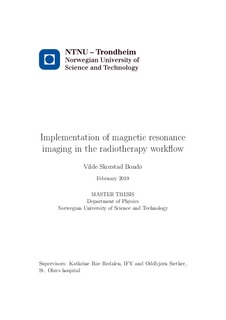| dc.contributor.advisor | Redalen, Kathrine Røe | |
| dc.contributor.advisor | Sæther, Oddbjørn | |
| dc.contributor.author | Bondø, Vilde Skorstad | |
| dc.date.accessioned | 2019-05-29T14:00:13Z | |
| dc.date.available | 2019-05-29T14:00:13Z | |
| dc.date.issued | 2019 | |
| dc.identifier.uri | http://hdl.handle.net/11250/2599478 | |
| dc.description.abstract | Tradisjonelt er computertomografi (CT) den mest brukte bildemodaliteten for planlegging av strålebehandling. Magnetisk resonansavbildning (MR) gir langt bedre bløtvevskontrast enn CT, noe som gjør det attraktivt å bruke MR til å identifisere både tumor og normalvev. CT-avbildning innehar en direkte link mellom signalintensiteten og elektrontettheten. Å kjenne denne elektrontettheten er nødvendig for beregning av stråledose. I MR finnes det ingen slik link, så MR-bilder blir gjerne fusjonert med CT-bilder for bruk i stråleterapiplanlegging. Denne typen fusjon introduserer et sett med feilkilder til planleggingen, og det kan derfor være hensiktsmessig å basere planleggingen på MR-bildene alene. Dermed er det nødvendig å generere elektrontetthetsinformasjon basert på MR-bildene, gjennom å lage en såkalt pseudo-CT (pCT). En annen problemstilling relatert til MR-basert stråleterapi er risikoen for geometriske forvrengninger i bildene. Denne typen forvrengninger kan påvirke nøyaktigheten av geometrien i bildene, noe som vil kunne påvirke nøyaktigheten i stråleterapiplanleggingen.
I denne oppgaven har en Siemens Biograph mMR scanner (Siemens Healthineers) blitt klargjort for MR-basert stråleterapi. Stråleterapispesifikt utstyr har blitt kjøpt inn, installert og testet. Dette utstyret inkluderer en laserbro, en flat bordtopp, torso- og hode/nakke-spoleholdere, MriPlanner (Spectronic Medical AB) programvare for dannelse av atlas-basert pCT og GRADE-fantomet (Spectronic Medical AB) for målinger og analyse av geometriske forvrengninger. Etter arbeidet med denne oppgaven er scanneren klargjort for MR-basert stråleterapi.
Gjennom retrospektiv stråleterapiplanlegging av ti pasienter med prostatakreft, ble den dosimetriske nøyaktigheten av atlas-basert pCT sammenlignet med "bulk density''-basert pCT som ble generert i stråleterapiplanleggingssystemet RayStation (RaySearch Laboratories AB). Den originale planleggings-CTen ble brukt som referanse for dosimetrisk nøyaktighet. Atlas-basert pCT ble funnet å være den mest nøyaktige metoden for disse ti pasientene.
Den geometriske forvrengningen ble målt over en periode på 44 dager, gjennom avbildning og analyse av GRADE-fantomet. Målingene viste variasjoner som tyder på at det er nødvendig å overvåke de mulige forvrengningene for å garantere tilstrekkelig nøyaktighet. Videre studier av geometrisk forvrenging og pCT-dannelse bør utføres, både for å bli bedre kjent med programvaren og garantere tilstrekkelig nøyaktighet før MR-basert stråleterapi tas i bruk i klinisk rutine. | |
| dc.description.abstract | Computed tomography (CT) has traditionally been the standard imaging modality used for radiotherapy treatment planning (RTP). However, the immense soft tissue contrast of magnetic resonance (MR) imaging makes it desirable to use MR imaging as an aid to improve the accuracy of tumor and normal tissue delineations for radiotherapy (RT). In CT imaging, there is a direct link between the voxel intensity and the electron density data, which is necessary for RT dose calculation. MR does not possess this link, so MR images have been fused with CT images for RTP. However, this type of image fusion introduces a set of errors. To base the RTP on MR alone, the electron density information has to be generated from the MR data through the creation of a pseudo-CT (pCT). Another issue related to MR-based RT is the presence of geometric distortions in MR imaging. Geometric distortions can decrease the geometric accuracy of the MR images, which would affect the accuracy of the RTP.
In this thesis, a Siemens Biograph mMR scanner (Siemens Healthineers) was set up for MR-based RT. RT specific MR-equipment was purchased, installed and tested. This equipment included a laser bridge, a flat table overlay, torso and head/neck coil holders, MriPlanner software (Spectronic Medical AB) for atlas-based pCT generation and the GRADE phantom (Spectronic Medical AB) for measurements of the geometric distortion. After the work with this thesis, all the RT-specific equipment is installed and tested, and the scanner is ready for MR-based RT.
Through retrospective RTP of ten prostate cancer patients, the dosimetric accuracy of the atlas-based pCTs generated through the MriPlanner software was compared to bulk density-based pCTs generated in the RTP system RayStation (RaySearch Laboratories AB). The original planning CT was used as the reference for dosimetric accuracy. For these ten patients, the atlas-based pCTs was found to be of higher dosimetric accuracy compared to the bulk density-based pCTs.
The geometric distortion was measured over a 44-day period through imaging and analysis of the GRADE phantom. The measurements of the geometric distortion over time showed some variations which suggest that monitoring the geometric distortion is necessary to ensure a sufficient geometric accuracy. Further studies are recommended for both the GRADE phantom measurements and the pCT generation, both to get more familiar with the software and to ensure a sufficient accuracy before clinical applications. | |
| dc.language | eng | |
| dc.publisher | NTNU | |
| dc.title | Implementation of magnetic resonance imaging in the radiotherapy workflow | |
| dc.type | Master thesis | |
